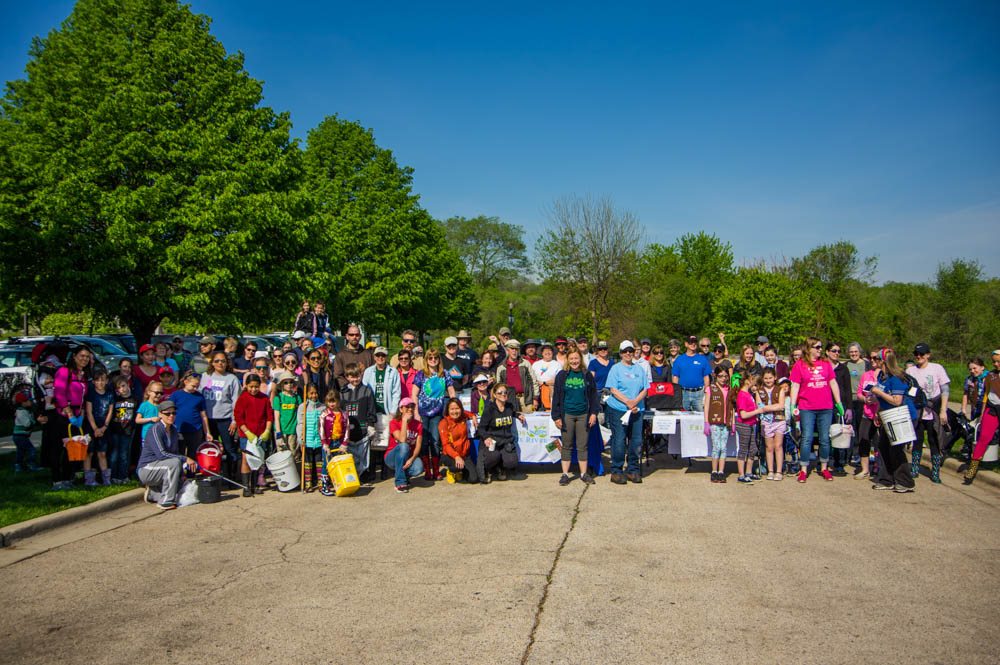By Gary Swick, President
Remember Hilary Clinton’s 1996 book, “It Takes a Village,” and her 2016 Democratic National Convention speech reminding us that alone  we can neither rear a healthy family, build a business, heal a community, or lift a country by ourselves? Collaboratively, we do better when we pool our skills, talents, perspectives, and energies. The same goes for those who protect the Fox River.
we can neither rear a healthy family, build a business, heal a community, or lift a country by ourselves? Collaboratively, we do better when we pool our skills, talents, perspectives, and energies. The same goes for those who protect the Fox River.
It’s OUR River
Friends of the Fox River (FOFR) was founded as a citizen advocacy organization to protect OUR river. Illinois water law is complicated; . What we definitely do own is the opportunity to enjoy its offerings through drinking water, irrigation, wildlife, natural beauty, recreational activities, and our wastewater delivery from pavement and homes. We must also own the responsibility to care for
Check Ups
 Once every five years, State of Illinois scientists from several agencies collaborate to check the water quality of our watershed at several locations. They rigorously collect biological, physical, and chemical data, which compared to previous years, offers a comprehensive picture of the trend. The good news is things are slowly but consistently recovering from decades of abuse.
Once every five years, State of Illinois scientists from several agencies collaborate to check the water quality of our watershed at several locations. They rigorously collect biological, physical, and chemical data, which compared to previous years, offers a comprehensive picture of the trend. The good news is things are slowly but consistently recovering from decades of abuse.
But is every five years enough? Would your doctor or dentist schedule wellness visits that far apart? Periodic check ups are fine for people who can schedule appointments, but the river and its tributaries run silent. It is therefore necessary to have a community of trained citizens/students to make house calls. That is where our Watershed Watchdog program is highly valuable. Each year our educators host over 5,000 students in their local streams to collect a basic version of the scientific data. And these visits can identify issues before they become chronic.
Construction Site Erosion
Native vegetation, and to a much lesser extent landscaped areas, allow precipitation to infiltrate into the soil where it is held in pore spaces 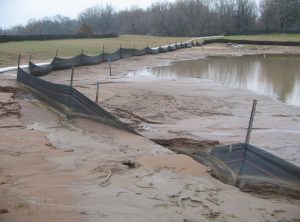 for use by the plants as needed. When the vegetation is removed the exposed soil often cannot absorb the water. The water runs off, powered by gravity, and usually brings soil particles with it. On construction sites there are required preventive measures used to minimize the resulting ecosystem damage. You may have seen the two-foot high black plastic walls known as silt fencing. When properly maintained, they are fairly effective in allowing water to pass through and hold the soil in place, unfortunately after it has eroded from somewhere uphill. Open gullies require flexible tools like fiber rolls that can bend to the land formation and block flows. These practices require monitoring of their integrity during and after storm events.
for use by the plants as needed. When the vegetation is removed the exposed soil often cannot absorb the water. The water runs off, powered by gravity, and usually brings soil particles with it. On construction sites there are required preventive measures used to minimize the resulting ecosystem damage. You may have seen the two-foot high black plastic walls known as silt fencing. When properly maintained, they are fairly effective in allowing water to pass through and hold the soil in place, unfortunately after it has eroded from somewhere uphill. Open gullies require flexible tools like fiber rolls that can bend to the land formation and block flows. These practices require monitoring of their integrity during and after storm events.
Runoff Rangers
Just like the periodic water quality monitoring, erosion control can benefit from additional eyes. FOFR, along with the Illinois Sierra Club, are planning to implement a citizen training for “Runoff Rangers” to identify and report construction site violations. Using our phones, we can instantly document evidence with time stamps and report any violations to the authorities. In this case, the authority is the Kane-DuPage Soil and Water Conservation District (KDSWCD). The challenge is that at any given time the office may be responsible for 100+ projects. Our surveillance work in the field saves them a trip and they can immediately call the responsible party. It is my experience that most pollution violators are not malicious in their intent. Sometimes the cause is ignorance, neglect, or just unforeseen circumstances. A call or visit usually results in correcting the situation.
Longmeadow Parkway
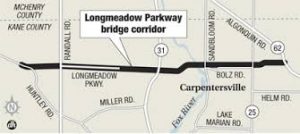 This project has had a long history of opposition, controversy, and a extensive list of concerns. The project has moved forward with the removal of numerous trees and extensive excavation. In its path on both sides of the river are areas where natural springs are present. These are places where groundwater is under pressure and pushed up to the surface. This winter/spring season repeatedly interrupted excavation and resulted in many soil erosion e
This project has had a long history of opposition, controversy, and a extensive list of concerns. The project has moved forward with the removal of numerous trees and extensive excavation. In its path on both sides of the river are areas where natural springs are present. These are places where groundwater is under pressure and pushed up to the surface. This winter/spring season repeatedly interrupted excavation and resulted in many soil erosion e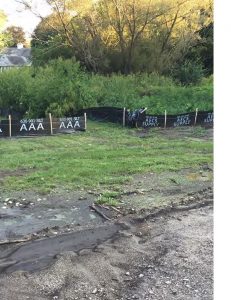 vents. Just west of Route 31, the project cleared a heavily wooded hillside resulting in a road cut that is 60 feet down into that hill. Rain has been its nemesis and the unanticipated additional groundwater stressed the project’s design and ability to handle the runoff. Detention basins silted up, reducing the holding capacity and Potawatomi Trail Creek ran muddy many times. An order of
vents. Just west of Route 31, the project cleared a heavily wooded hillside resulting in a road cut that is 60 feet down into that hill. Rain has been its nemesis and the unanticipated additional groundwater stressed the project’s design and ability to handle the runoff. Detention basins silted up, reducing the holding capacity and Potawatomi Trail Creek ran muddy many times. An order of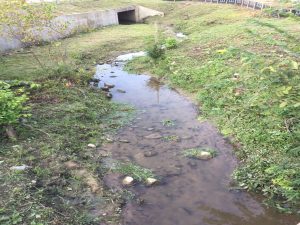 non-compliance was voluntarily filed with the Illinois Environmental Protection Agency and the US Army Corps of Engineers. According to KDSWCD, the consultants and contractors were making an effort above and beyond what was in their Stormwater Pollution Prevention Plan by addressing the issue using advanced technologies such as filter bags with polymers to enhance soil separation.
non-compliance was voluntarily filed with the Illinois Environmental Protection Agency and the US Army Corps of Engineers. According to KDSWCD, the consultants and contractors were making an effort above and beyond what was in their Stormwater Pollution Prevention Plan by addressing the issue using advanced technologies such as filter bags with polymers to enhance soil separation.
Members of the Jelke Creek Fox Watershed Coalition and FOFR were very concerned. Each time a small stream receives a big sediment load it alters the physical habitat, resulting in significant biological devastation. Two days later, the stream may be running clear, but the damage was done, and recovery is slow or not possible. Field observation began and research and review of the project’s plans was conducted. KDSWCD made frequent visits and contractors acted in response.
Community Means Inclusion
A meeting was requested to review the situation and look forward to prevention, restoration, and future actions. On Earth Day, members from JCFRWC, FOFR, Kane DuPage Soil & Water Conservation District (KDSWCD), two Kane County Board members, Kane County Department of Transportation (KDOT), and several consultant/contractors met at the Schweitzer Environmental Center. After two hours of questions, answers, explanations, discussion, and inquiries, a better understanding of all sides was achieved. KDOT and their consultants left with a list of questions and concerns that would require more research. This was a good example of why it is essential for collaboration because through our field surveillance, communication, and working with the responsible parties we achieved better results.
Protecting Redhorse Habitat
20 years ago, IDNR Fisheries Biologist Bob Rung contested the drainage plan for the Rt 34 expansion based upon its potential impact upon 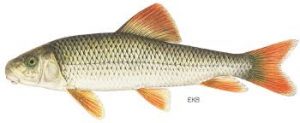 a State endangered species, the Greater Redhorse. Most recently, FOFR member Don Lupei added comments on an updated plan. Project engineers developed and implemented a new technique for retaining drainage water on site. Even with record spring rains, the system is successful and the habitat has not been impacted.
a State endangered species, the Greater Redhorse. Most recently, FOFR member Don Lupei added comments on an updated plan. Project engineers developed and implemented a new technique for retaining drainage water on site. Even with record spring rains, the system is successful and the habitat has not been impacted.
Bonnie Raitt is a fan of FOFR
Earlier this year, FOFR was invited to a James Taylor/Bonnie Raitt concert by Green Highway. Green Highway offers non-profit organizations table space to enhance the concert experience for participants and to support local activism. During the concert Bonnie Raitt gave FOFR a  shout out, encouraging fans to visit our table, and acknowledging, “we do good work.” Receiving that kind of recognition and support was affirming and I was very proud of our organization at that moment.
shout out, encouraging fans to visit our table, and acknowledging, “we do good work.” Receiving that kind of recognition and support was affirming and I was very proud of our organization at that moment.
Be a Caretaker
Bonnie Raitt often ends her shows with a plea for everyone to “take care of each other.” That is what a community does. FOFR works to create a watershed of caretakers. Please consider upping your involvement in FOFR. We need your help on our committees, and are always looking for business partners and folks to help with our many events. Consider contacting us to discuss your particular skills/interests and find your place in our FOFR community.

